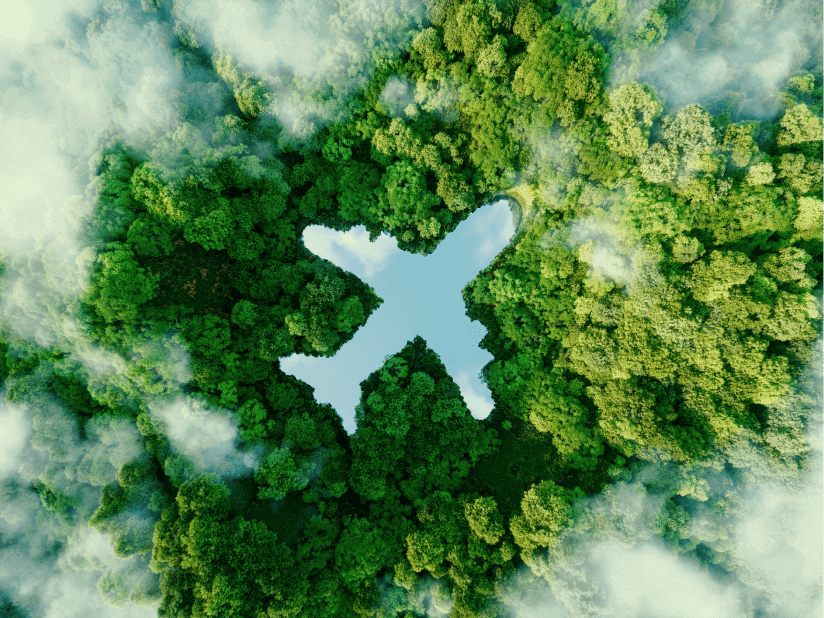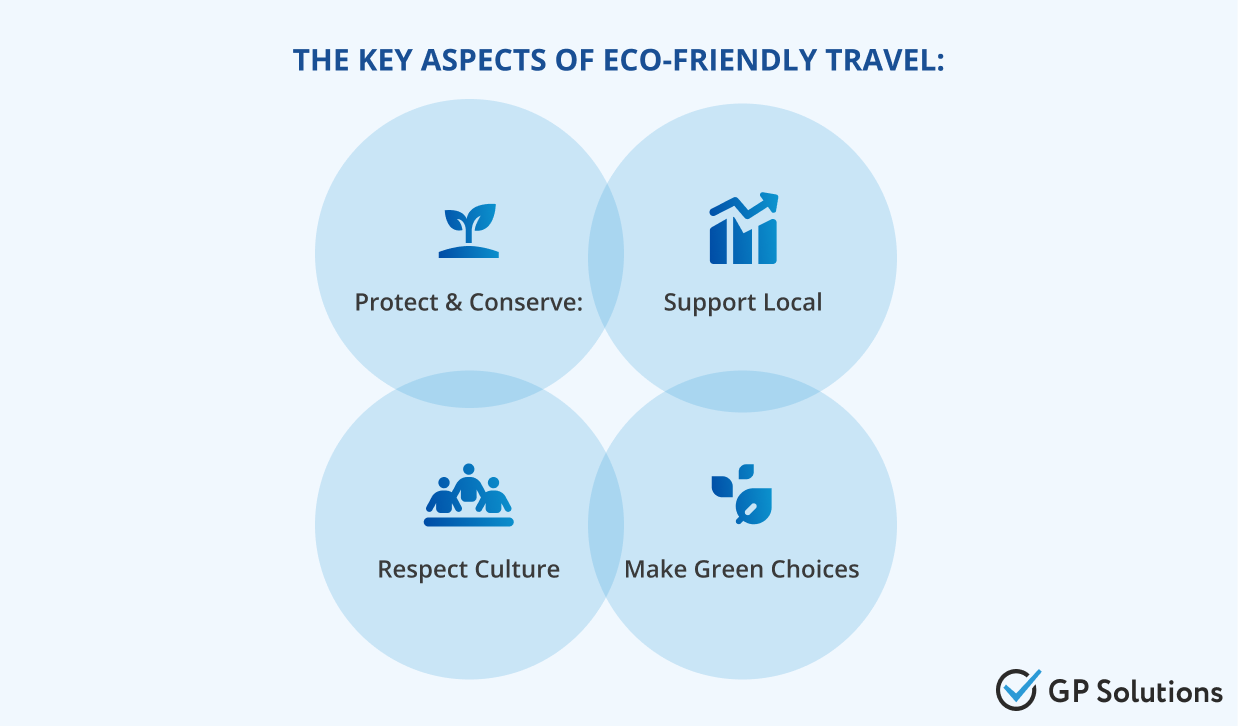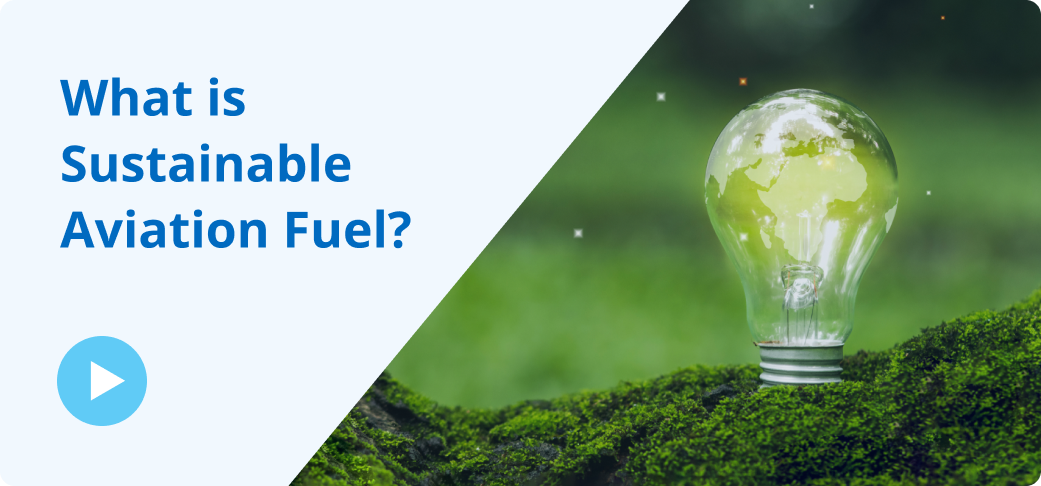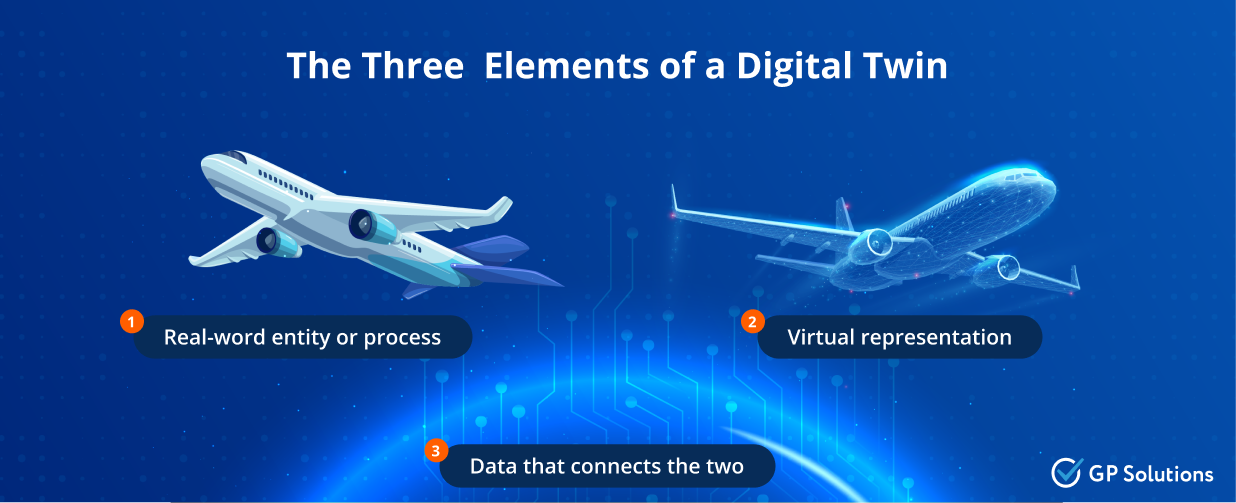- en
- de
Meet Us at Connect Spring Marketplace!
Meet Us at Connect Spring Marketplace!

The negative influence of travel on the environment conditions in local communities has become quite considerable. Greenhouse gases (tourism activity makes up for around 8 percent of the total carbon emissions produced worldwide (three-quarters of them being due to aviation), excessive use of local resources and pollution (e.g., marine waste volumes go up by 40 percent at the peak of tourism season) are just some of the issues created by travel activities.
Many tourists and companies in the industry today tend to adopt various eco-friendly measures, move to safe energy sources and waste management practices. In this article, we’ll explore in more detail what digital technology brings to the table in terms of sustainable travel products and solutions.
Sustainable travel, also called ‘ecotourism’ or simply ‘responsible travel’, stands for making choices that reduce harm to places of visit. Each separate choice may not seem too big, but together they make a great difference.
Practicing sustainable travel is just taking the ‘good guest attitude’ everywhere you’re lucky enough to visit. This makes it not just about minimizing the harmful influence. It also involves providing beneficial influence, such as taking care of cultural heritage , protection of nature and ecosystems, taking care of local community needs and so on.

“Looking for the right travel tech expertise to implement a new idea? — Let’s discuss your requirements.”
Travel is a privilege. When you go to a new place, you are staying as a guest. Sustainable travellers remember this at all times and strive to preserve and protect tourist sites. This way they allow future travellers to have the same great experience they had.

Nowadays sustainability has turned into one of the most influential trends in global travel.
These days people tend to travel consciously and responsibly, so that airlines, accommodation providers and tour operators / agencies have to move along and take care of their customer needs.
Here are the key areas one can pay special attention to in order to provide a ‘greener’ service:
The biggest part of these categories involve practical actions, making use of different fuels, or installation of specific appliances. Nevertheless, modern digital technology can make a huge positive impact too. Let’s take a look at how exactly.
In 2015, 197 countries made an agreement to decrease greenhouse emissions in an effort to limit the effects of global warming. Hundreds of companies have already supported this initiative by setting net-zero emission targets. The list involves some of the top carriers such as British Airways, Japan Airlines, American Airlines and a number of others.
It’s quite obvious that the industry has a heavy dependence on energy (specifically fossil fuels), which produce large amounts of greenhouse gases – the key cause of climate change. Below are some practical ways to address this issue with the help of digital technology.
In May 2021, Alaska Airlines partnered with Flyways AI, which is an ML-based solution for flight monitoring designed by Airspace Intelligence. It helps dispatchers arrange flight operations in a more sustainable way, optimize flight routes, and make airline traffic flow much more predictable.
The system takes into account numerous parameters determining the efficiency of planned and active flights. It can predict scenarios, while also issuing immediate advice and recommendations. For instance, if there’s a more convenient route to avoid turbulence or just simply a better route, it sends a notice to flight dispatchers who then decide whether to accept the provided recommendation or not. This is the way of building the most fuel-efficient routes possible.
Numerous airline carriers give their passengers an option to find out about the exact carbon footprint left by their flight, select an eco-friendlier option and also take part in various environment preservation programs. This is a convenient way not only to make up for the damage made by the carbon emissions, but also to convey responsibility and awareness.
Specifically, Alaska Airlines was proclaimed the most fuel-efficient carrier from 2010 up to 2017. In 2021 the company also set out to return possession of this title in the next 5 years.

Other airline carriers such as Air Canada, Virgin Atlantic and more get to make partnership agreements with various ventures (Climate Care, atmosfair and others) that also determine flight emission volumes and offer options to compensate the damage caused.

In addition to the aforementioned measures, the airline industry is also coming up with new ways to promote wider use of sustainable and eco-friendly fuels on jet engines. This kind of activity has a huge potential for improving the situation with poisonous emissions.

A perfect example of such an initiative is the Roundtable for Sustainable Biomaterials (RSB). This organization maintains its own unique solution — RSB Book & Claim Platform. This system is designed to support RSB’s work in promoting a robust model for driving broader decarbonization of human activity. Its specific focus is on the aviation industry. RSB’s Book & Claim solves the issue of high eco-fuel costs compared to traditional fuels. The platform allows everyone who is interested to partially finance eco-fuel production and delivery by purchasing the so-called ’Book & Claim Units (BCUs), or ‘credits’. Every participant is also provided with special certificates that confirm participation in eco-fuel production.

As of today, the Book & Claim System has become a very secure and credible space for various interested companies willing to help promote sustainable biofuel distribution. There are also plans to expand the platform into the maritime shipping industry.
Hotels, vacation rental operators along with other hospitality businesses are heavy resource consumers and generators of waste. Helping them stick to greener ways via technology can assist in tackling environmental issues, reducing expenses and attracting eco-active clients.
One of the major steps towards sustainable operations is establishing ways to decrease resource usage. Nowadays, numerous technologies provide energy use monitoring and managing capabilities for rooms or even entire facilities. Below you can learn more about some examples that already operate successfully.
Numerous residential and commercial buildings (hotels as well) have already moved to specialized energy-saving and cost-effective appliances based on the Internet of Things (IoT) approach. These include:
A study released in 2020 revealed that an IoT-enabled HVAC (heating, ventilation, air conditioning) solution provided 75 to 95 percent more comfort to customers and limited daily energy use by 20 percent during peak hours of heat in summer time.
What concerns real-life success stories, there are quite a lot to mention. Below are some of the most prominent among them to date:

For getting the most out of IoT devices, they are usually connected to central monitoring and control systems like building automation or energy management platforms.
Throughout the recent years, Artificial Intelligence (AI) technology has been a major driving force of sustainability changes both in travel as a whole and the hospitality industry in particular. It has a game-changing effect in helping hotels, resorts, and restaurants decrease environmental damage while upholding the highest standards of service.
In this sense, AI-driven energy management systems (EMSs) are at the forefront of green initiatives in hospitality. They’ve proven to be highly productive in monitoring and optimizing energy consumption by processing large volumes of data and providing efficient recommendations for higher energy efficiency. Also, AI-driven EMSs generate comprehensive insights into energy consumption stats with the help of:
Systems of this type can analyze data by room, floor, building and across numerous different properties. They can also produce real-time notifications, alerting operators of any excessive or unusual energy consumption. A strong example here is BrainBox AI — an AI-enabled tool built for analysis and adjustment of HVAC systems for achieving optimal performance, productivity and efficiency.
AI-powered building automation systems (BASs) provide control over the entire spectrum of hotel facility functions, from lighting or HVAC (heating, ventilation, air conditioning) to plumbing, elevator supervision or security measures. Systems like this are convenient for operators since they can be managed from a central hub and supervised using a specialized digital platform or a mobile app.
Another efficient application of AI in hospitality is food waste tracking. Statistics show that the hospitality industry alone accounts for around 18 percent of the total food waste, which has become a massive source of greenhouse gas emissions. With this in mind, the industry is putting tremendous efforts into working out solutions to reduce waste amounts, save food and generate additional energy from waste recycling.
Here is a real-life example of how an AI-enabled solution can now tackle the food waste problem:

More on Artificial Intelligence in hospitality – in a separate article by Forbes.
Water is another type of resource that has to be treated and managed properly. Hotels may consume water in huge volumes. Excessive consumption takes place not only in individual rooms, but also for covering various needs related to housekeeping, pools, irrigation, cleaning and more. Different estimations show that water accounts for approximately 10 percent of the total utility bill of a hotel.
Water consumption can be controlled using water meters. They can be used to identify abnormal cases of water usage and discover water leaks. Solutions of this type typically consist of data loggers interconnected with pulse outputs of the water meter alongside a software infrastructure aggregating data and visualizing valuable insights. They are also provided with alarms notifying operators about cases of abnormal water consumption.

A couple of years ago, Sheraton Seattle Hotel applied the latest solutions in water metering and monitoring. As a result it saved over $36,000 within a year. It estimated its total water consumption, discovered hidden problems and improvement areas (for example, applying a new shower head, faucet or a laundry installation). Ultimately, its total volume of saved water amounted to 25 million gallons in 6 years.
When it comes to new technology, there’s practically no limit for improvement and innovation. Here are a few new solutions that can provide increased sustainability in the coming future.
[phase class=”mt-1 mb-3″ element=”h3″]Predictive equipment maintenance[/phase]
In essence, predictive maintenance provides advanced equipment servicing using a proactive approach. By applying IoT tools and analytical programming solutions with ML capabilities you can keep monitoring the performance of your assets and discover proactively when maintenance might be needed. This way it is possible to secure proper functioning and eliminate cases of failure.

Maintenance done on time increases asset efficiency (which often leads to lower energy / fuel consumption) and helps avoid buying new appliances (which also needs energy for output and transport).
Digital copies, or ‘twins’, is one of the latest tech solutions fostering the tech sustainability trend. Specifically, they allow to:

Today, it won’t be sufficient to just install bins for separated waste collection or encourage guests to reuse towels in order to fall into the eco-friendly category. Although these are quite good measures to go for at first, airlines, hotels, tour companies and agencies need to practice a conscious approach to global issues by applying very targeted and practical measures. Besides, travel businesses need to also educate customers about sustainability and encourage eco-friendly choices while travelling. This could include offering information about local conservation efforts or promoting activities with a low environmental impact. If you’re relying on travellers for revenue, it’s essential to know your customers and their inclination towards sustainable travel practices.
There’s a vast area for improvement in terms of sustainability for all types of travel businesses. And it is highly important to work consistently and work together if we want to preserve a cleaner and safer environment for the next generations.
Leave your request
We will contact you shortly
Thank you for your request!
We will get back to you as quickly as possible
Get latest insights
from our travel tech experts!
Join 200+ travel fellows! Get GP Solutions' latest articles straight to your inbox. Enter your email address below:
Thank You!